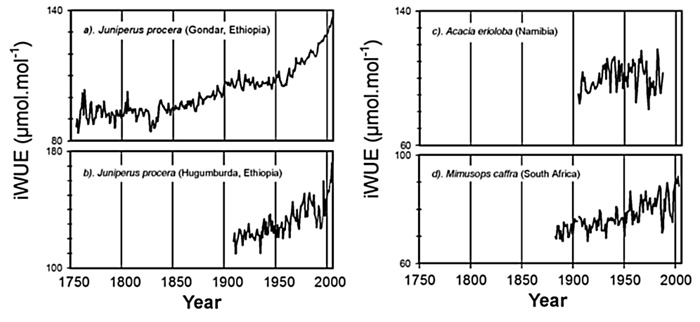| Follow @co2science |
Paper Reviewed
Wils, T.H.G., Robertson, I., Woodborne, S., Hall, G., Koprowski, M. and Eshetu, Z. 2016. Anthropogenic forcing increases the water-use efficiency of African trees. Journal of Quaternary Science 31: 386-390.
This they did by studying either cores or discs of wood extracted from five Juniperus procera trees of Gondar, Ethiopia, and one from the Hugumburda forest on the north-western escarpment of the Ethiopian Rift Valley, along with discs obtained from a Mimusops caffra tree growing in South Africa's KwaZulu-Natal, together with an Acacia erioloba growing in the Koichab Valley of Namibia. And what did these efforts reveal?
The six scientists -- hailing from Ethiopia, Poland, South Africa, the Netherlands and the United Kingdom -- report that, in their entirety, "tree-ring intrinsic water-use efficiency (iWUE) records for Africa show a 24.6% increase over the 20th century" (see Figure 1 below). And because a high iWUE can partly counterbalance decreases in precipitation, Wils et al. conclude that this finding "has important implications for those involved in water resource management and highlights the need for climate models to take physiological forcing into account."
Last of all, they further report that "the 24.6% increase in mean iWUE confirms that African trees are already adapting to increasing atmospheric CO2 concentrations," as appears to be the case throughout the entire world, as may be seen by perusing the host of examples of this fact that are archived under the heading of Water Use Efficiency (Trees) in our web site's Subject Index.

Figure 1. Annual intrinsic water-use efficiency (iWUE) from eight African trees calculated over the period 1755-2006. (a) Mean iWUE from five Juniperus procera individual trees growing in a church compound at Gondar in the north-western Ethiopian Highlands; (b) iWUE from Juniperus procera growing at Hugumburda on the northwestern escarpment of the Ethiopian Rift Valley; (c) iWUE from Acacia erioloba growing in the Koichab Valley in Namibia; and (d) iWUE from Mimusops caffra growing in KwaZulu-Natal in South Africa. Source: Wils et al. (2016).




